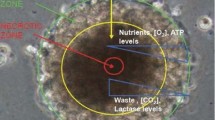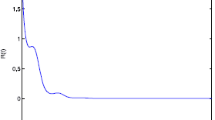Abstract
This paper is devoted to studying a free boundary problem modeling the effects of drug resistance and vasculature on the response of solid tumors to therapy. The model consists of a system of partial differential equations governing intra-tumoral drug concentration and cancer cell density. By applying the L p theory of parabolic equations and the Banach fixed point theorem, it is proved that this problem has a unique global classical solution.
Similar content being viewed by others
References
Baxter L, Yuan F, Jain R. Pharmacokinetic analysis of the perivascular distribution of bifunctional antiboies and haptens: comparison with experimental data, Cancer Res, 1992, 52:5838–5864.
Byrne H, Chaplain M. Growth of necrotic tumors in the presence and absence of inhibitors, Math Biosci, 1996, 135: 187–216.
Byrne H, Chaplain M. Free boundary value problems associated with the growth and development of multicellular spheroids. Euro J Appl Math, 1997, 8: 639–658.
Cui S. Analysis of a mathematical model for the growth of tumors under the action of external inhibitors, J Math Biol, 2002, 44: 395–426.
Cui S. Global existence of solutions for a free boundary problem modelling the growth of necrotic tumors, Interfaces Free Bound, 2005, 7(2): 147–159.
Cui S. Analysis of a free boundary problem modelling tumor growth, Acta Math Sinica (English Series), 2005, 21 (5): 1071–1082.
Cui S. Existence of a stationary solution for the modified Wark-King tumor growth model, Adv Appl Math, to appear.
Cui S, Friedman A. Analysis of a mathematical model of the effect of inhibitors on the growth of tumors, Math. Biosci, 2000, 164: 103–137.
Cui S, Friedman A. Analysis of a mathematical model of the growth of necrotic tumors, J Math Anal Appl, 2001, 255: 636–677.
Cui S, Friedman A. A free boundary problem for a singular system of differential equations: an application to a model of tumor growth, Trans Amer Math Soc, 2002, 355: 3537–3590.
Cui S, Friedman A. A hyperbolic free boundary problem modelling tumor growth, Interfaces Free Bound, 2003, 5: 159–181
Cui S, Wei X. Global existence for parabolic-hyperbolic free boundary problem modelling tumor growth, Acta Math Appl Sinica (English Serious), 2005, 21 (4): 597–614.
Friedman A, Reitich F. Analysis of a mathematical model for the growth of tumors, J Math Biol, 1999, 38: 262–284.
Friedman A, Reitich F. Symmetry-breaking bifurcation of analytic solutions to free boundary problems, Trans Amer Math Soc, 2000, 353: 1587–1634.
Friedman A, Reitech F. On the existence of spatially patterned dormant malignancies in the model for the growth of non-necrotic vascular tumor, Math Models Appl Sci, 2000, 11: 601–625.
Greenspan H. Models for the growth of solid tumors by diffusion, Stud Appl Math, 1972, 51: 317–340.
Greenspan H. On the growth and stability of cell cultures and solid tumors, J Theor Biol, 1976, 56: 229–242.
Jackson T, Byrne H. A mathematical model to study the effects of drug resistance and vasculature on the response of solid tumors to chemotherapy, Math Biosci, 2000, 164: 17–38.
Jain R. Transport of macromolecules across tumor vasculature. Cancer Metastasis Rev, 1987, 6: 559–561.
Kerr D, Schreiber G, Vrudhula V, et al. Regressions and cures of melanoma xenografts following treatment with monoclonal antibody β-lactamase conjugates in combination with anticancer prodrugs, Cancer Res, 1995, 55: 3558–3563.
McElwain D, Pettet G. Cell migration in multicell spheroids: swimming against the tide, Bull Math Biol, 1993, 55: 655–674.
Pettet G, Please C, McElwaim M. The migration of cells in multicell tumor spheroids, Bull Math Biol, 2001, 63: 231–257.
Sherrat J, Chaplain M. A new mathematical model for vascular tumor growth, J Math Biol, 2001, 43: 291–312.
Thompson K, Byrne H. Modelling the internalization of labeled cells in tumor spheroids. Bull Math Biol, 1999, 61: 601–623.
Ward J, King J. Mathematical modelling of vascular tumor growth II, IMA J Math Appl Biol Med, 1997, 14: 53–75.
Ward J, King, J. Mathematical modelling of vascular tumor growth, IMA J Math Appl Biol Med, 1998, 15: 1–42
Author information
Authors and Affiliations
Additional information
Supported by the National Natural Science Foundation of China (10471157).
Rights and permissions
About this article
Cite this article
Fujun, Z. Analysis for a free boundary problem modeling tumor therapy. Appl. Math.- J. Chin. Univ. 21, 143–151 (2006). https://doi.org/10.1007/BF02791351
Received:
Issue Date:
DOI: https://doi.org/10.1007/BF02791351




